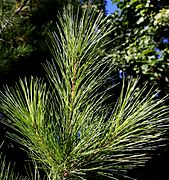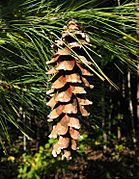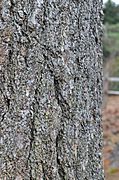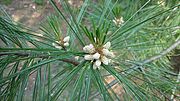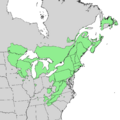Eastern white pine facts for kids
Quick facts for kids Eastern white pine |
|
|---|---|
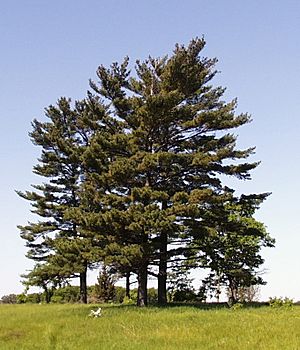 |
|
| Pinus strobus group | |
| Conservation status | |
| Scientific classification | |
| Genus: |
Pinus
|
| Species: |
strobus
|
The Pinus strobus, often called the eastern white pine, northern white pine, or just white pine, is a very large pine tree. It grows naturally in eastern North America. You can find it from Newfoundland, Canada, all the way west through the Great Lakes region to southeastern Manitoba and Minnesota in the United States. It also grows south along the Appalachian Mountains to northern Georgia. It's quite rare in Indiana.
The Native American Haudenosaunee people called this tree the "Tree of Peace". In the United Kingdom, it's known as the "Weymouth pine." This name comes from Captain George Weymouth of the British Royal Navy, who brought its seeds to England from Maine in 1605.
Contents
Where Eastern White Pines Grow
The eastern white pine lives in the temperate broadleaf and mixed forests of eastern North America. It likes soils that drain well or are sandy, and it prefers humid (moist) weather. However, it can also grow in wet, boggy areas and on rocky hills.
In mixed forests, this tall tree stands out above many others, even some large hardwood trees. It provides food and shelter for many forest animals, like the red crossbill bird and small animals such as squirrels.
Scientists have found old white pine leaves and pollen in places like the Gulf Coastal Plain, where the tree doesn't grow anymore. This shows that its range used to be larger.
Long ago, eastern white pine forests covered huge parts of north-central and north-eastern North America. But after a lot of logging from the 1700s to the early 1900s, only about one percent of these original, very old forests are left.
Today, some of these old forests are protected in places like Great Smoky Mountains National Park. Other protected areas with old white pine forests include Algonquin Provincial Park in Ontario, Canada, and Cook Forest State Park in Pennsylvania, United States.
Sometimes, small groups or even single old eastern white pines can be found across the USA, like in Maine and New York.
The eastern white pine has also been planted in other parts of the world, like the Carpathian Mountains in the Czech Republic and southern Poland. It has spread from these planted trees and now grows naturally there.
What Eastern White Pines Look Like
Like most "white pines," the eastern white pine has long, thin leaves called "needles." These needles grow in bundles of five, or sometimes three or four. They are flexible, bluish-green, and have tiny saw-like edges. Each needle is about 5 to 13 centimeters (2 to 5 inches) long.
The seed cones are long and slender, usually 8 to 16 centimeters (3 to 6 inches) long. When they open, they are about 4 to 5 centimeters (1.5 to 2 inches) wide. The scales on the cones have a rounded tip and are often sticky with resin. The seeds inside are small, about 4 to 5 millimeters (0.16 to 0.2 inches) long, and have a thin wing about 15 to 20 millimeters (0.6 to 0.8 inches) long. The wind helps spread these seeds. The tree produces a lot of cones every 3 to 5 years.
The branches of the eastern white pine grow in rings around the trunk, spaced about 45 centimeters (18 inches) apart. Each ring has 5 to 6 branches, looking a bit like spokes on a wagon wheel.
Eastern white pines can grow very old. Many mature trees are 200–250 years old, and some can live for over 400 years. One tree near Syracuse, New York, was found to be 458 years old in the late 1980s. Some trees in Michigan and Wisconsin are around 500 years old.
-
Pollen cones and young needles in late June
-
Large white pine in Southern Ontario, Canada.
How Big Do They Get?
The eastern white pine is known for being the tallest tree in eastern North America. Before colonial times, some trees were said to grow as tall as 70 meters (230 feet). While it's hard to know for sure, it's possible some trees reached this amazing height.
The largest eastern white pines can have a trunk volume of about 28 cubic meters (1,000 cubic feet). Some past giants might have been even bigger.
How Tall?
Eastern white pines grow about 1 meter (3 feet) taller each year between the ages of 15 and 45. They grow slower before and after that age. The tallest living eastern white pines today are about 50 to 57.55 meters (164 to 189 feet) tall. Before they were heavily logged, it was common for white pines in northern Wisconsin to be over 60 meters (200 feet) tall.
The southern Appalachian Mountains have many of the tallest eastern white pines today. One famous tree, called the "Boogerman Pine," in Great Smoky Mountains National Park, is 57.55 meters (189 feet) tall. It is the tallest accurately measured tree in North America east of the Rocky Mountains. Before a hurricane broke its top in 1995, it was even taller, at 63 meters (207 feet).
In the northeastern USA, several places have trees over 48 meters (157 feet) tall. Cook Forest State Park in Pennsylvania has many eastern white pines over 45 meters (148 feet) tall. The "Longfellow Pine" in this park is the tallest living eastern white pine in the Northeast, at 55.96 meters (183.6 feet) tall.
How Wide?
The trunks of larger eastern white pines can be from 1.0 to 1.6 meters (3.3 to 5.2 feet) wide. This means their circumference (the distance around the trunk) can be from 3.1 to 5.0 meters (10 to 16 feet). However, it's very rare to find single-trunked white pines wider than 1.45 meters (4.8 feet).
Some old stories from colonial times claimed that virgin white pines could be up to 2.4 meters (8 feet) wide!
Tree Health and Diseases
Eastern white pines are somewhat resistant to fire. This means that after a fire, older trees can survive and help new trees grow in the burned areas. In pure stands (where only white pines grow), mature trees usually don't have branches on the lower part of their trunks.
However, two main problems can harm or kill these trees: the white pine weevil (an insect) and white pine blister rust (a fungus that came from other countries).
Blister Rust
In the early 1900s, white pine blister rust killed a lot of mature white pines, sometimes 50–80% of them. This fungus needs to live part of its life on other plants, like native gooseberry or wild currant bushes.
At one time, foresters thought they could get rid of the rust by removing all these other plants. So, people were encouraged to dig up and destroy all native gooseberry and wild currant plants in areas where pines were grown for wood. This was done to protect the timber industry.
Today, native wild currants are not very common in New England. In some places, it's even against the law to plant wild currants or gooseberries. But now, new types of commercial currants have been developed that are very resistant to white pine blister rust. Because of this, only about 3% of white pines die from the rust today.
Conservation Status
Old white pines are highly valued in the United States. Cook Forest State Park, which is an American National Natural Landmark, has the tallest known tree in the northeastern United States, the "Longfellow Pine." Some white pines in Wisconsin are over 200 years old. Even though white pines are planted a lot in yards in the Midwest, the native white pine is listed as "rare or uncommon" in Indiana.
Historical Uses of White Pine
Lumber
In the 1800s, cutting down white pine forests in the Midwest was a big part of America's move westward. For example, in one year, a quarter million white pines were cut down and sent to lumber yards in Chicago.
People like Henry David Thoreau thought the white pine was a beautiful tree. But it was also very useful for business. It was considered "the most wanted and most used of the various forest growths."
Here's what a writer from the 1800s said about its uses:
Because it is soft and easy to work with, and takes paint better than almost any other wood, it has been used for everything in building, from making packing boxes to strong beams and fine finishes in homes. It is light, so it could be easily moved to farms in the west, where it was used for building houses, barns, and corn cribs. It was also excellent for fences. Except for things that needed very strong wood, like building ships or wagons, white pine was good for all uses where wood was needed, even for simple furniture. No other wood was liked more or used as much to meet people's needs from the forest.
In 1620, Captain George Weymouth brought the species to England to grow for timber. But he didn't have much success because of the white pine blister rust disease.
Old pine wood from various pine species in the Americas was highly desired. This was because huge, knot-free boards were common. Pine was also easy to cut. So, many colonial homes used pine for walls, floors, and furniture. Loggers also liked pine trees because pine logs could be cut into boards a year or more after the tree was felled. Most hardwood trees, like cherry or oak, had to be cut into boards right away or they would crack.
Even though eastern white pine was often used for floors in buildings before the U.S. Civil War, the wood is soft. Over time, it would tend to bend or cup with wear. George Washington chose the much harder southern yellow pine for his home at Mount Vernon instead.
Masts for Ships
During the 1600s and 1700s, tall white pines in the Thirteen Colonies were known as "mast pines." Agents of The Crown (the British King) would mark these trees with a special symbol called the broad arrow. This meant the tree was reserved for the British Royal Navy to use as ship masts.
Special boats were built to carry these tall white pines to England. The wood was often cut into squares to fit better in the ships. A 30-meter (100-foot) mast would be about 0.9 x 0.9 meters (3 x 3 feet) at the bottom and 0.6 x 0.6 meters (2 x 2 feet) at the top. A 37-meter (120-foot) mast would be even bigger.
By 1719, Portsmouth, New Hampshire, became a main center for cutting and shipping pine. That year, Portsmouth sent 199 masts to England. In total, about 4,500 masts were sent to England.
The King's marking of large white pines became a big problem in the colonies. In 1734, the King's men were attacked in Exeter, New Hampshire, in what was called the Mast Tree Riot. In 1772, the sheriff was sent to the town of Weare to arrest mill owners for having large white pines illegally. That night, an angry group of colonists attacked the sheriff. This act of rebellion, later called the Pine Tree Riot, might have helped lead to the Boston Tea Party in 1773. So, the eastern white pine played an important role in the events that led to the American Revolution.
After the Revolutionary War, the new United States used large white pines to build its own navy. The masts of the USS Constitution (a famous warship) were originally made of eastern white pine. These first masts were single trees, but they were later replaced with stronger, layered masts to better handle cannonballs.
In colonial times, a very large, single white pine was found in coastal South Carolina, far from where it usually grows. The king's mark was carved into it, which led to the town being named Kingstree.
Modern Uses
Lumber
Eastern white pine is still used for lumber today.
Timber Framing
Eastern white pine is often used for timber frames in buildings and can be found in large sizes. However, eastern white pine timbers are not super strong, so they need to be larger to hold heavy loads. This wood takes stains well, but it doesn't resist rot much, so it should only be used in dry places.
Eastern white pine is now widely grown in tree farms (plantations) in its native areas.
Characteristics
When eastern white pine is freshly cut, it is yellowish-white or a light straw color. But pine wood that has aged for many years tends to turn a deep, rich golden tan. Sometimes you can find light brown pine boards with unusual yellowish-golden or reddish-brown colors. This is called "pumpkin pine." People think that slow-growing pines in old forests develop these colors in their inner wood, but genetics and soil might also play a role.
This wood is also liked by people who make patterns because it's easy to work with.
Foods and Medicines
Eastern white pine needles have more vitamin C than lemons and oranges and can be used to make a great herbal tea. The inner bark (called the cambium) can be eaten. It also contains a healthy substance called resveratrol. In the 1700s, Carl Linnaeus noted that cattle and pigs grew well when fed pine bark bread, but he didn't like the taste himself.
Pine tar is made by slowly burning pine roots, branches, or small trunks with limited air. Pine tar mixed with beer can be used to get rid of tapeworms or nematodes (round worms). Pine tar mixed with sulfur is helpful for treating dandruff and is still used in some products today. Pine tar can also be used to make turpentine.
The name "Adirondack" is an Iroquois word meaning "tree-eater." It referred to their neighbors, the Algonquians, who would collect the inner bark of eastern white pine and other trees during times of winter hunger. The soft, white inner bark was carefully separated from the hard, dark brown bark and dried. When pounded, this product could be used as flour or added to other starchy foods to make them last longer.
The young male cones were cooked by the Ojibwe Indians with meat and were said to be sweet and not sticky. Also, the seeds are sweet and nutritious, but not as tasty as those from some western nut pines.
Pine resin (sap) was used by different Native American tribes to make baskets, pails, and boats waterproof. The Chippewa also used pine resin to treat infections and even serious wounds. This is because pine resin has substances that fight germs. Usually, a wet pulp from the inner bark, or pine tar mixed with beeswax or butter, was put on wounds as a salve to prevent infection.
Cultivation
Pinus strobus is grown by plant nurseries as an ornamental tree for gardens and parks. It's easy to care for and grows quickly as a single tree. With regular trimming, it can also be shaped into a hedge. Some types are even used in bonsai.
Cultivars
Different types of eastern white pine have been chosen for their smaller sizes or special needle colors. Some examples include:
- Pinus strobus Nana Group — usually about 90 cm (3 ft) tall and 1.2 m (4 ft) wide. MBG: Pinus strobus (Nana Group)
- Pinus strobus 'Macopin' — 30 to 90 cm (1 to 3 ft) tall and wide. MBG:Pinus strobus 'Macopin'
- Pinus strobus 'Paul Waxman' — 60 to 150 cm (2 to 5 ft) tall and wide. MBG: Pinus strobus 'Paul Waxman'
Christmas Trees
Smaller eastern white pines are popular as live Christmas trees. They are known for keeping their needles well, even long after being cut. They are also good for people with allergies because they don't have much scent. A standard 1.8-meter (6-foot) tree takes about 6 to 8 years to grow in good conditions. People often prefer trimmed varieties because they have the classic cone shape of a Christmas tree. Naturally grown ones can become too thick for larger ornaments. The branches of the eastern white pine are also widely used to make holiday wreaths and garlands because of their soft, feathery needles.
Symbolism
The eastern white pine is the Provincial Tree of Ontario, Canada.
In the United States, it is the State Tree of Maine (since 1945) and Michigan (since 1955). Its "pine cone and tassel" is also the State Flower of Maine and is shown on the state's license plates.
Branches of eastern white pine were worn as badges to symbolize Vermont identity during the Vermont Republic. They are also shown in a stained glass window in the Vermont State House, on the Flag of Vermont, and on the naval ensign (flag) of the Commonwealth of Massachusetts and the state of Maine. The 1901 Maine Flag also clearly showed the tree during its short time as Maine's state flag. The Maine State Guard also uses the tree in their uniform badges.
The Native American Haudenosaunee (Iroquois Confederation) called it the "Tree of Peace".
Images for kids
-
Native eastern white pine, Sylvania Wilderness, Michigan
-
Partial distribution map of Pinus strobus in North America
See also
 In Spanish: Pino de Weymouth para niños
In Spanish: Pino de Weymouth para niños



